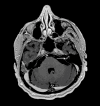Morvan Fibrillary Chorea Associated with Monoclonal B Cell Lymphocytosis
- PMID: 38963810
- PMCID: PMC11322787
- DOI: 10.12659/AJCR.943867
Morvan Fibrillary Chorea Associated with Monoclonal B Cell Lymphocytosis
Abstract
BACKGROUND Morvan fibrillary chorea (Morvan syndrome) is a rare disorder marked by a collection of neurological symptoms such as myokymia, peripheral nerve excitability, neuromyotonia, autonomic instability, memory impairment, and delirium. Morvan syndrome is suspected to occur through antibodies directed against voltage gated potassium channels (VGKC), and has been linked with several autoimmune conditions and hematologic malignancies. We present a case of Morvan syndrome in association with monoclonal B cell lymphocytosis. Upon our literature review, we believe this to be the first documented case of Morvan syndrome associated with monoclonal B cell lymphocytosis. CASE REPORT The present case report describes a 75-year-old man with Morvan's syndrome. The patient had a diverse neurologic presentation with encephalopathy, progressive neuropathic pain, muscle fasciculations, myokymia, sensory deficits, and Bell's palsy. Ultimately, a paraneoplastic antibody panel revealed a positive titer of contactin-associated protein-like IgG (CASPR) and VGKC antibody. Flow cytometry showed a small population of abnormal lambda-restricted B cells. Given his symptoms, positive CASPR antibody, and flow cytometry findings, he was diagnosed with Morvan syndrome associated with monoclonal B cell lymphocytosis. He was treated with IV methylprednisolone and IVIG, with immediate improvement in neurologic symptoms. CONCLUSIONS Morvan syndrome presents with a spectrum of neurologic symptoms and is associated with autoantibodies against VGKC through anti-CASPR2 antibodies. Classically, Morvan syndrome presents as a paraneoplastic disease secondary to thymomas. Our case demonstrates that there is an association between B cell lymphoproliferative disorders and Morvan syndrome.
Conflict of interest statement
Figures


References
-
- Liguori R, Vincent A, Clover L, et al. Morvan’s syndrome: Peripheral and central nervous system and cardiac involvement with antibodies to voltage-gated potassium channels. Brain. 2001;124(Pt 12):2417–26. - PubMed
-
- Orphanet: Morvan syndrome. Cited: Mar. 20, 2022[Online]. Available: https://www.orpha.net/en/disease/detail/83467?name=ORPHA:83467&mode=orpha.
-
- Barber PA, Anderson NE, Vincent A. Morvan’s syndrome associated with voltage-gated K+ channel antibodies. Neurology. 2000;54(3):771–72. - PubMed
-
- Singh R, Das P, Kaur U, et al. Morvan’s syndrome-is a pathogen behind the curtain? Neurol Sci. 2018;39(11):1965–69. - PubMed
Publication types
MeSH terms
LinkOut - more resources
Full Text Sources

